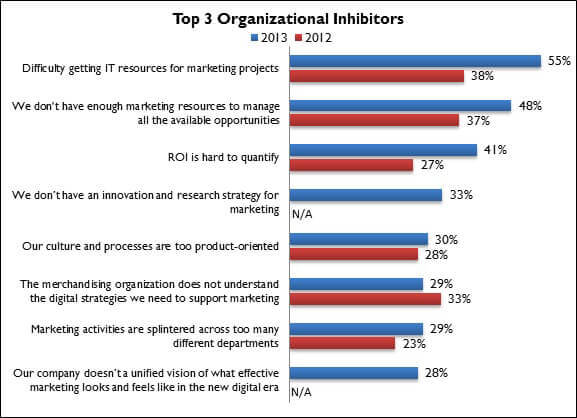What’s Keeping Retailers From Better Marketing?
The relative importance of marketing within the retail enterprise has rapidly been rising, driven largely by the need to keep the cross-channel promises retailers have been making to their consumers for some time now. Indeed, retailers are busy consolidating their marketing activities and elevating marketing leadership from a supporting role for merchandising to a genuine seat at the executive table.
Still, just because the future looks bright for the marketing department, retailers are not necessarily well-positioned to deliver on customer expectations, whether in terms of the brand promise, the product value proposition, or the shopping experience. In our latest report, Retail Marketing 2013: Organizational Drift, we posit that marketing is on the cusp of becoming something different than we’ve seen in retail before. But the question remains: will retailers get there? Or will their existing culture, process, and technology hold them back?
As you can see below, Figure 1 confirms just how plausible that concern is.
Figure 1: The More Things Change, the More They Stay the Same

Source: RSR Research, August 2013
Last year’s top three organizational inhibitors take their exact place at the top of the list again – only this time, all three (difficulty getting IT resources, a lack of resources to manage new opportunities, and difficulty proving ROI in the first place) are even greater obstacles to retailers. In fact, at a time when respondents to many of our most recent topic-specific benchmark reports are telling us that the need to prove ROI is waning, it appears that marketing functions still require quite a bit of convincing and education when pushing them up the ranks. For some retailers (some more than others, as we’ll see in just a moment), just because Marketing now has a space at the big table doesn’t mean everyone there has bought in yet.
We were also very surprised to see that in, aggregate, “we don’t have an innovation and research strategy for marketing ” – a first time option, was identified as a roadblock by 1 in 3 retailers.
However, when viewed by performance, we can see that laggards are the driving force behind many of these trends (Figure 2).
Figure 2: Winners Tread Lightly Around Org Change and Culture

Source: RSR Research, August 2013
While difficulty getting IT resources for marketing project remains ubiquitous for retailers of all kinds, laggards are most likely to report that their marketing resources are already overstretched and that they need help proving the ROI is there in the first place. It is also worth noting that more than twice as many laggards as winners report that need for an innovation and research strategy for marketing. It’s going to be tough for them to get anywhere without that.
By contrast, Winners are more likely to report that their culture and processes are too-product oriented – indeed, they’re making a conscious effort to tread lightly around changing their internal culture and processes, for fear of upsetting the entirety of their day-to-day operations too quickly. At the same time, Winners readily admit that their marketing activities are splintered across too many different departments. This, too, signifies that they understand the need for systematic change in order to bring a new level of marketing to a new type of consumer, but that their existing infrastructure will need to be coaxed along: gently.
We hope you take the time to read the full report, which is available by following this link; we found it to be full of interesting takeaways.
